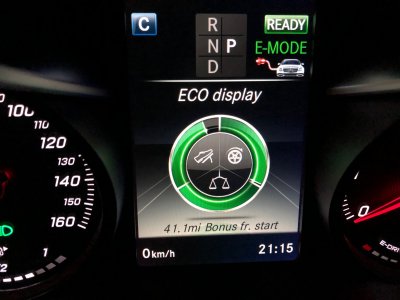The car should be able to maintain motorway speeds on battery alone, assuming it has some capacity left. It should also be able to accelerate ‘moderately’ up to speed without using the ICE. All being well, you get about 90bhp of electric motive power (with decent charge in the battery). That’s enough to cruise along at legal speeds, accelerate reasonably well enough to keep up with general traffic.
If yours won’t do more than 15mph on the flat on a full charge without firing up the ICE then it is clearly faulty. The symptoms sound as if the battery has very low capacity. It sounds like it behaves like mine does on an almost flat battery. The “swingometer” under the tacho doesn’t give a constant reading I don’t think. By that, I mean that 3 white LEDs on a full battery is more power than 3 white LEDs on an empty one, just based on how it feels when driving. I think it's more like a proportion of available power rather than an absolute power gauge.
Again, I’ll ask, have you tried to work out how much electrical energy you are actually putting into it when charging?
On the dash, set charge current to 10A (to make the maths simple).
Again on the dash (or main display) find out battery charge state.
Put it on charge and note what time you start. Keep an eye on it and note when it finishes (100% charged), or if that isn’t convenient, when it reaches a known %age of charge. Try to let it charge for at the very least an hour to minimise errors.
You can now work out how much energy you put in to get it from the starting figure to the ending one.
You know it was charging at about 2.3kW. You know how long it was charging for. Multiply the time it was charging (in hours) by 2.3, that tells you how much energy you put in, in kWh.
You know how charged it was at the start and the end, so you can work out how many % of capacity you added by charging. End %age minus start %age.
Total battery capacity is then (roughly!!!), (100/%age charge added) x energy added in kWh.
There are errors and assumptions in this, but it should give a decent indication if there is anything drastically wrong.
of course, it would be much easier if you had a fixed wall charger that did the sums for you like some of the new ones do.

I do a similar check to this from time to time on mine. I have solar PV and a Tesla Powerwall so can easily monitor how much power is going into the house, so it’s easy for me to see how long mine is on charge for and how much it took. Usually works out to around 6kWh or so, which is about right given the errors and assumptions involved in testing like this. If it came back very different to that, I’d know there was something wrong.
Once you have an idea of the actual battery capacity, you can then have an idea where to look for the problem.


